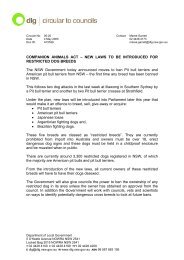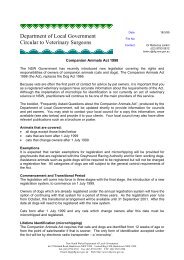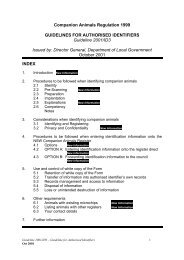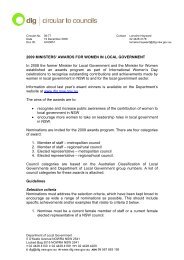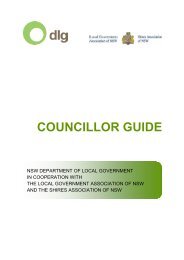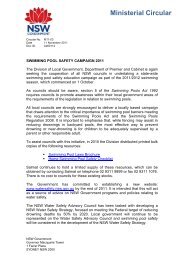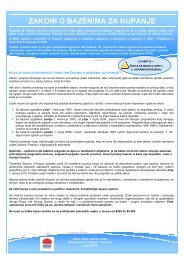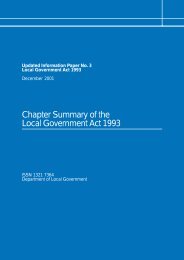Integrated Planning and Reporting Manual - Division of Local ...
Integrated Planning and Reporting Manual - Division of Local ...
Integrated Planning and Reporting Manual - Division of Local ...
You also want an ePaper? Increase the reach of your titles
YUMPU automatically turns print PDFs into web optimized ePapers that Google loves.
I NTRODUCTION<br />
Integrating council plans <strong>and</strong> reports<br />
The new framework recognises that communities do not exist in isolation – they are part <strong>of</strong> a larger<br />
natural, social, economic <strong>and</strong> political environment that influences <strong>and</strong>, to a large extent, shapes<br />
their future direction.<br />
Neither do council plans exist in isolation – l<strong>and</strong> use <strong>and</strong> infrastructure planning produces social,<br />
environmental <strong>and</strong> economic outcomes, <strong>and</strong> vice-versa – they are connected.<br />
This framework encourages councils to draw their various plans together, to underst<strong>and</strong> how they<br />
interact <strong>and</strong> to get the maximum leverage from their efforts by planning holistically for the future.<br />
It recognises that most communities share similar aspirations: a safe, healthy <strong>and</strong> pleasant place to<br />
live, a sustainable environment, opportunities for social interaction, opportunities for employment,<br />
reliable infrastructure, etc. The difference lies in how each community responds to these needs.<br />
That is what shapes the character <strong>of</strong> individual towns <strong>and</strong> cities.<br />
The new framework opens the way for councils <strong>and</strong> their communities to have important<br />
discussions about funding priorities, service levels <strong>and</strong> preserving local identity <strong>and</strong> to plan in<br />
partnership for a more sustainable future.<br />
The framework has been developed after extensive consultation with the local government sector<br />
<strong>and</strong> other key stakeholders.<br />
Commencing under the new framework <strong>and</strong> transition arrangements<br />
The <strong>Local</strong> Government Amendment (<strong>Planning</strong> <strong>and</strong> <strong>Reporting</strong>) Act 2009 provides transitional<br />
provisions for phasing in the legislative requirements <strong>of</strong> the integrated planning <strong>and</strong> reporting<br />
framework over a three-year period. Councils will decide which <strong>of</strong> three Groups they will commence<br />
in. The timeframe for each <strong>of</strong> the Groups is as follows:<br />
Group 1: Community Strategic Plan <strong>and</strong> Delivery Program adopted by 30 June 2010<br />
Group 2: Community Strategic Plan <strong>and</strong> Delivery Program adopted by 30 June 2011<br />
Group 3: Community Strategic Plan <strong>and</strong> Delivery Program adopted by 30 June 2012.<br />
Transitional provisions provide that councils continue to operate under the legislative requirements<br />
in place prior to the Amendment Act, until such time as their Group commences under the new<br />
<strong>Integrated</strong> <strong>Planning</strong> <strong>and</strong> <strong>Reporting</strong> framework. Councils have been particularly interested in<br />
clarifying their responsibilities during the transition period in relation to the following:<br />
Social/community plans<br />
Under the previous legislation all general purpose councils must have a social/community plan for<br />
their area. These must be submitted to DLG every five years. Most councils submitted<br />
social/community plans in November 2004, <strong>and</strong> were therefore due to submit again by 30<br />
November 2009.<br />
Under the new <strong>Integrated</strong> <strong>Planning</strong> <strong>and</strong> <strong>Reporting</strong> framework, there is no longer a requirement for a<br />
separate social/community plan. However, social planning by councils continues to be a critical part<br />
<strong>of</strong> councils’ business, but will now be integrated into a more strategic <strong>and</strong> streamlined approach to<br />
planning. Identified actions in existing social/community plans which may not have progressed into a<br />
council’s annual management plan will now be embedded into the strategic planning framework.<br />
This elevates the importance <strong>of</strong> social planning by councils.<br />
<strong>Planning</strong> & <strong>Reporting</strong> <strong>Manual</strong> Page 9 <strong>of</strong> 115





